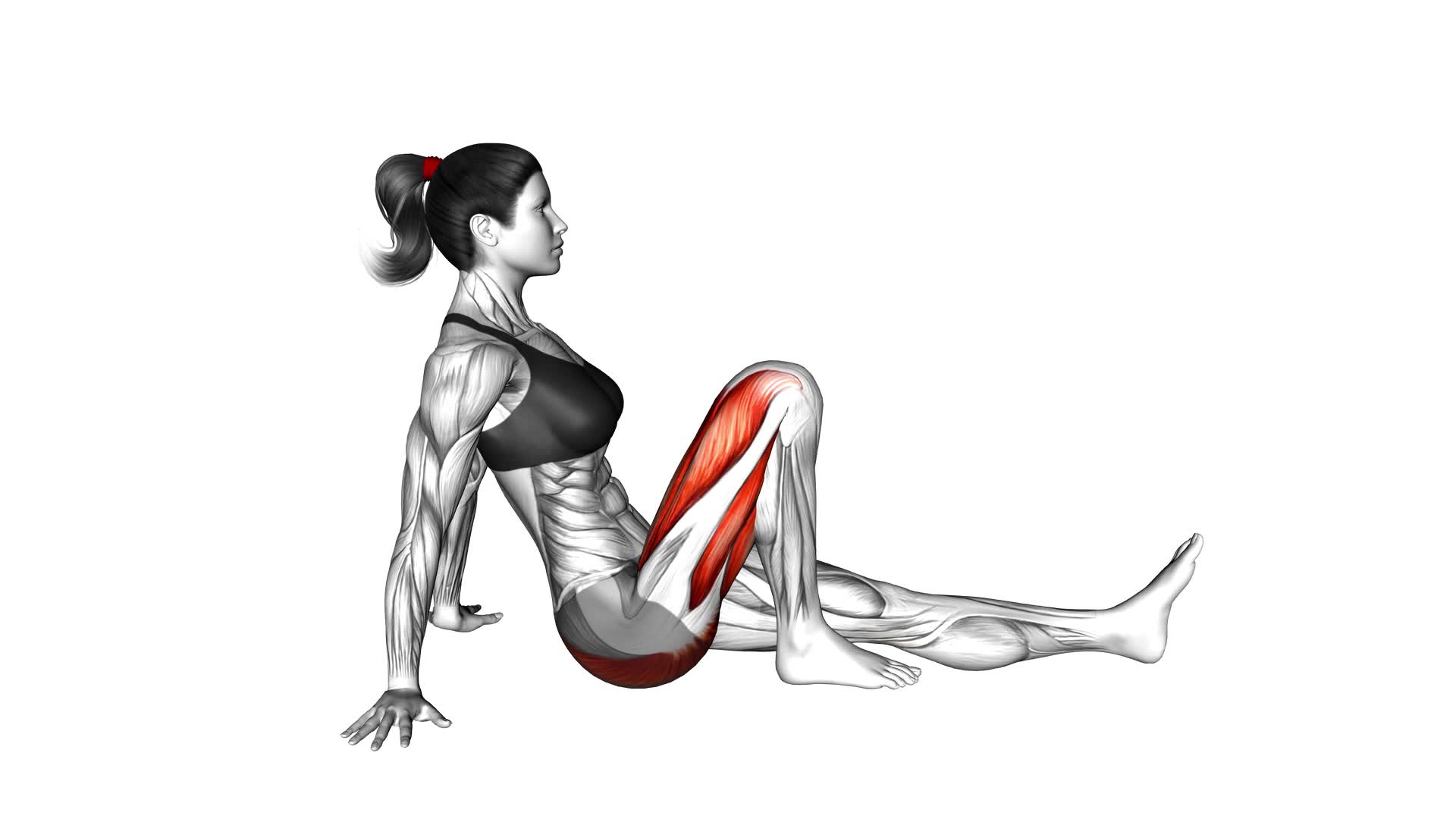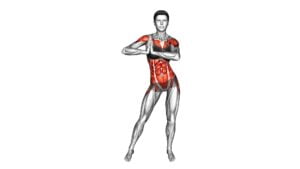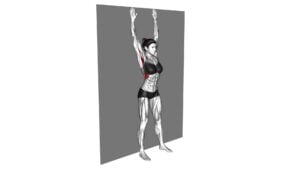Seated Knee Slide (female) – Video Exercise Guide & Tips

Are you looking for an effective exercise to target your lower body? Look no further than the seated knee slide.
Watch This Exercise Video
In this video exercise guide, we'll show you the proper form and technique for performing this move.
With just a few minutes each day, you can strengthen your legs and improve your overall fitness.
Get ready to slide your way to success!
Key Takeaways
- The seated knee slide is beneficial for improving flexibility, strengthening core muscles, enhancing range of motion, and maintaining proper posture.
- Proper form and technique include keeping the back straight, engaging core muscles, controlling the movement, maintaining a neutral spine, and breathing properly.
- Common mistakes to avoid during the exercise include using momentum, rounding the back, not maintaining proper form, and not engaging thigh and hip muscles.
- To maximize results, it is important to maintain proper form, gradually increase intensity, avoid rushing through the exercise, focus on engaging core muscles, and start with recommended sets and reps.
Benefits of the Seated Knee Slide
Discover the numerous benefits of incorporating the seated knee slide into your fitness routine. This exercise is highly effective in improving flexibility and strengthening your core. By regularly performing the seated knee slide, you can enhance the range of motion in your lower body, particularly in your hips and knees. This increased flexibility can be highly beneficial in various activities such as sports, dance, and everyday movements.
Additionally, the seated knee slide engages your core muscles, including your abdominals and obliques, helping to build a strong and stable midsection. Strengthening your core is essential for maintaining proper posture, preventing lower back pain, and improving overall athletic performance. The seated knee slide targets these muscles by requiring you to engage your core to stabilize your body as you slide your knees in and out. As a result, you can develop a stronger and more stable core, which can have a positive impact on your overall fitness and well-being.
To ensure you get the most out of the seated knee slide, it's important to focus on proper form and technique. By maintaining proper alignment, engaging your core, and performing the exercise with control, you can maximize the benefits and minimize the risk of injury. Let's explore the proper form and technique in the next section.
Proper Form and Technique
To perform the seated knee slide with proper form and technique, you need to focus on engaging your core and maintaining control throughout the exercise. Here are some valuable tips to ensure you execute this exercise correctly:
- Keep your back straight: Proper posture is essential to avoid straining your lower back. Make sure to sit up tall and avoid slouching.
- Engage your core: Activate your abdominal muscles by pulling your belly button in towards your spine. This will help stabilize your torso and protect your back.
- Control the movement: Slowly slide your knees apart, maintaining control throughout the entire range of motion. Avoid any jerky or sudden movements.
- Maintain a neutral spine: Avoid arching or rounding your back during the exercise. Keep your spine in a neutral position to protect your spine and maintain proper alignment.
- Breathe properly: Remember to inhale deeply through your nose and exhale fully through your mouth. This will help you stay focused and maintain a steady rhythm.
Common mistakes to avoid include using momentum to slide your knees apart and rounding your back. If you find this exercise too challenging, you can modify it by sliding your knees apart to a comfortable distance. To progress, you can increase the resistance by using a resistance band or adding ankle weights.
Remember to always listen to your body and work within your capabilities.
Equipment Needed for the Exercise
To perform the seated knee slide exercise, you'll need minimal equipment. All you need is an exercise mat or a comfortable surface to sit on. The mat will provide cushioning and support for your knees during the exercise. It's important to choose a mat that's thick enough to protect your knees from any discomfort or injury.
When it comes to exercise modifications, there are a few options you can consider. If you have knee pain or mobility issues, you can place a pillow or cushion under your knees for added support. This will help to reduce any discomfort and allow you to perform the exercise with ease. Additionally, you can also use a resistance band around your thighs to add extra resistance and challenge to the exercise.
Now let's talk about common mistakes to avoid while performing the seated knee slide. One common mistake isn't maintaining proper form throughout the exercise. It's important to keep your back straight, engage your core, and avoid leaning forward or backward. Another mistake is using momentum to slide your knees instead of using controlled movements. Remember to focus on the muscles in your thighs and hips to ensure proper engagement and effectiveness of the exercise.
Alternative Variations of the Seated Knee Slide
If you're looking to add variety to your seated knee slide exercise, try incorporating alternative variations that target different muscle groups. Here are some modified variations and advanced techniques you can try:
- Single-Leg Seated Knee Slide: Extend one leg straight out while sliding the other knee in towards your chest. This variation increases the challenge and targets your core and hip flexors.
- Reverse Seated Knee Slide: Instead of sliding your knees forward, slide them backward, pushing against the resistance. This targets your hamstrings and glutes.
- Seated Knee Slide with Resistance Band: Place a resistance band around your knees and perform the knee slide. The band adds extra resistance, engaging your outer hip muscles.
- Stability Ball Seated Knee Slide: Sit on a stability ball and perform the knee slide. This challenges your balance and activates your core muscles.
- Seated Knee Slide with Medicine Ball: Hold a medicine ball between your knees while performing the knee slide. This increases the resistance and works your inner thigh muscles.
Incorporating these modified variations and advanced techniques into your seated knee slide routine can help you target different muscle groups and keep your workouts challenging.
Now, let's move on to some tips for maximizing your results.
Tips for Maximizing Results
To maximize your results with the seated knee slide exercise, focus on maintaining proper form and gradually increasing the intensity of your workouts. This will help you achieve the desired outcomes and avoid common mistakes that can hinder your progress.
One common mistake is rushing through the exercise without paying attention to the correct technique. Remember to keep your back straight and engage your core muscles throughout the movement. This will ensure that you're targeting the right muscles and getting the most out of each rep.
In terms of recommended sets and reps, it's generally suggested to start with 2-3 sets of 10-12 repetitions. As you become more comfortable and stronger, you can gradually increase the number of sets and reps. However, it's important to listen to your body and not push yourself too hard too soon. It's better to start slow and gradually progress rather than risking injury or burnout.
Additionally, don't forget to warm up before starting the exercise and cool down afterward. This will help prevent muscle soreness and stiffness. Lastly, remember to breathe properly throughout the exercise, inhaling on the way back and exhaling as you slide your knees forward.
Frequently Asked Questions
Can the Seated Knee Slide Exercise Be Modified for Individuals With Knee Injuries or Limitations?
Yes, the seated knee slide exercise can be modified for individuals with knee injuries or limitations.
There are various seated knee slide variations that can be done to accommodate different needs. These modifications may include reducing the range of motion, using resistance bands for support, or performing the exercise on a stability ball.
How Many Calories Does the Seated Knee Slide Exercise Burn?
The seated knee slide exercise is a great way to strengthen your muscles and burn calories.
It's important to note that the number of calories burned during this exercise can vary depending on factors such as your weight and intensity.
To get the most out of the seated knee slide exercise, it's recommended to do it regularly and incorporate it into your fitness routine.
The best time to do the seated knee slide exercise is when you have a few minutes to spare and want to get your heart rate up.
Can the Seated Knee Slide Exercise Help Improve Flexibility in the Hips?
The seated knee slide exercise can significantly improve flexibility in your hips. Athletes can benefit from this exercise as it targets the hip flexors and increases range of motion.
Incorporating seated knee slide variations into your routine can also provide advanced flexibility training. By regularly practicing this exercise, you'll notice increased hip mobility and flexibility, which can enhance your overall athletic performance.
It's a great addition to any training regimen.
What Muscles Does the Seated Knee Slide Exercise Primarily Target?
The seated knee slide exercise primarily targets the muscles in your hips and thighs. By incorporating this exercise into your regular routine, you can improve your flexibility and strengthen these muscle groups.
There are variations of the seated knee slide for beginners and advanced fitness levels, allowing you to progress at your own pace. Adding this exercise to your workout can provide numerous benefits, such as increased range of motion and enhanced lower body strength.
Can the Seated Knee Slide Exercise Be Incorporated Into a Full-Body Workout Routine?
Yes, the seated knee slide exercise can be incorporated into a full-body workout routine. It targets the core muscles, particularly the abs and obliques. By adding variations and modifications, you can increase the intensity and engage other muscle groups.
Incorporating the seated knee slide into your routine offers several benefits, including improved core strength, stability, and flexibility. It's a versatile exercise that can be done anywhere, making it a great addition to your workout routine.
Conclusion
In conclusion, the seated knee slide is a beneficial exercise for females, targeting the muscles in the lower body. By maintaining proper form and technique, using the required equipment, and incorporating alternative variations, individuals can maximize their results.
This exercise can help improve strength, flexibility, and overall fitness levels. Incorporating the seated knee slide into a regular workout routine can contribute to a well-rounded fitness program.

Author
Years ago, the spark of my life’s passion ignited in my mind the moment I stepped into the local gym for the first time. The inaugural bead of perspiration, the initial endeavor, the very first surge of endorphins, and a sense of pride that washed over me post-workout marked the beginning of my deep-seated interest in strength sports, fitness, and sports nutrition. This very curiosity blossomed rapidly into a profound fascination, propelling me to earn a Master’s degree in Physical Education from the Academy of Physical Education in Krakow, followed by a Sports Manager diploma from the Jagiellonian University. My journey of growth led me to gain more specialized qualifications, such as being a certified personal trainer with a focus on sports dietetics, a lifeguard, and an instructor for wellness and corrective gymnastics. Theoretical knowledge paired seamlessly with practical experience, reinforcing my belief that the transformation of individuals under my guidance was also a reflection of my personal growth. This belief holds true even today. Each day, I strive to push the boundaries and explore new realms. These realms gently elevate me to greater heights. The unique combination of passion for my field and the continuous quest for growth fuels my drive to break new ground.



